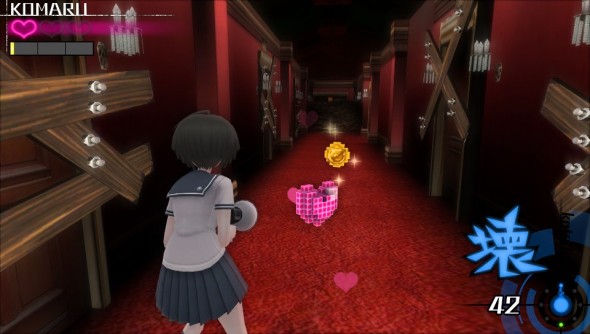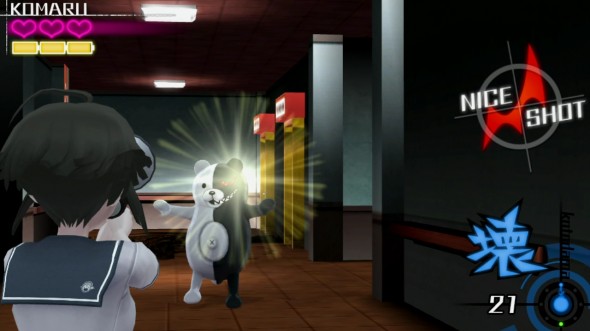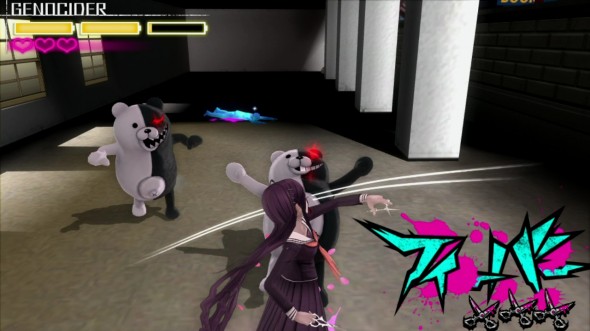Reviews
Danganronpa Another Episode: Ultra Despair Girls
October 29, 2015, Author: Andy Corrigan
Danganronpa: Trigger Happy Havoc and its sequel, Goodbye Despair, were two of my favourite surprises last year. These ‘visual novels’ provided plots as fascinating as they were twisted, set in a world where classmates at an elite school are forced to murder each other at the behest of an evil plushie called Monokuma. After being delighted by brilliant characters, strong themes of despair and paranoia, and an eccentric story woven in masterfully with crime scene investigation and trial elements, I was pretty much down for whatever Spike Chunsoft’s next installment would bring.
Only, after the dialogue-heavy, point and click nature of the previous games, I wasn’t expecting that next installment, Danganronpa Another Episode: Ultra Despair Girls, would be a spin-off action game with Resident Evil-style shooting mechanics. I also wasn’t expecting that it’d be uncharacteristically… well… a bit rubbish…
Danganronpa Another Episode: Ultra Despair Girls follows the story of Komaru Naegi (whose surname might seem familiar to fans of the series) as she is kidnapped and held captive in a luxurious apartment in Towa City for a year during the “biggest, most awful, most tragic event in human history“, an event often referenced in the previous games. Fed and watered at least, she is left to her own devices, blissfully unaware of the chaos currently raging outside her building’s walls.
That blissful existence ends suddenly, however, when hordes of Monokuma robots smash through her door and try to rip her limb from limb. While a team from the Future Foundation – led by a familiar face in Byakuya Togami – intervene to save her, the rescue attempt is botched, leaving Komaru trapped in a city under the control of five deranged children hell-bent on killing adults using deadly Monokumas.
Still, Komaru doesn’t have to face the terrors of Towa City alone and unarmed. Firstly, she has access to a handy gadget courtesy of the Future Foundation; a ‘hacking gun’ that, aside from being her main source of fire power, provides plenty of uses thanks to a variety of ammo types. She also soon teams up with another survivor in Toko Fukawa, an interesting character for reasons I’m hesitant to spoil, but who also proves useful in ways I’ll detail shortly.

Komaru has lots of heart…
Let’s be clear: The subject matter in Ultra Despair Girls is dark – in some cases possibly even more so than the core games – as it deals not only in stories of murder, but also torture, abuse and creepy exploitation, and does so with its cutesy anime art style that only ever makes events seem all the more disturbing. Some might not have the stomach for some of this content, but as someone who enjoys fiction that makes them uncomfortable, I quite like this side to the Danganronpa series. It handles it all with such a weird self-awareness, almost with a mischievous wink, and I find it impossible to not to play along.
This is especially true when it came to learning about the five antagonists, The Warriors of Hope, who are delightfully evil but also brilliantly multi-layered. Unfortunately, you’re left waiting way too long before the reveals of their personal motivations, but each has a horrific backstory to explain why they are how they are, and one of them in particular I still feel absolutely awful for, even now.
Sadly, despite having characters that are just as compelling and just as horrifying as the previous efforts, the overarching plot itself is painfully straightforward and, on the whole, predictable. This disappointed me no end as a series fan. With Danganronpa you expect twists and turns, and even when you have predicted correctly, something else usually comes out of leftfield to take you by surprise or make you look at events in a different light. That rarely happens here during the five chapters. Worse still, Ultra Despair Girls has a huge amount of dialogue comparable its visual novel counterparts, but it always comes at the worst times, rarely furthers the story satisfactorily, and causes things to drag at the times you’d just want to move things forward.
The meat of Ultra Despair Girls focuses on running around Towa City and destroying killer Monokuma robots, and this is done using the aforementioned ‘Hacking Gun’. At first it seems to play a lot like a mordern-era Resident Evil, what with the third-person view and the laser-sight used to aim at the enemies, but sadly it handles nowhere near as smoothly.
All Monokumas have the same weakness: Their glowing red right eye. Hit this and you can take down standard size enemies down in one shot, and do more damage to larger foes. So inaccurate is the hit detection, so wayward the aiming, and pathetic the visual and audio feedback, however, that this involves more luck than skill. Don’t get me wrong, I scored plenty of successful eye shots, but it was rare that I felt it was because I had lined my aim well under pressure and not because the game decided I had probably hit the target. Other times I was certain I’d hit my mark, only for it to count as a standard shot, which is doubly frustrating.
When you do successfully score a kill this way, by way of reward, your next shot will kill an enemy in one-hit regardless of where you hit them. While this bonus does help massively with crowd control when you’re being swarmed, it’s a shame that the mechanics required to earn it are so flawed.

Line ’em up…
Ultra Despair Girls tries its best to keep things interesting by regularly throwing new enemy types at you at least. There are grenade-lobbing Monokuma, Monokumas that alert others to your presence, shield-carrying Monokumas capable of blocking your shots, and so many more including larger, far more powerful monstrosities. Along with this, you’re also drip-fed new bullet-types, switchable on the fly, to help you cope with these shifts.
The grenadier enemies, for example, are best taken down with the ‘Knockback’ bullets, which not only sends them to the ground, but also scatters their inventory of explosives across the floor, potentially taking out a crowd of others with them. Other foes require combinations of bullets to be killed; the shield carriers can be knocked over using Knockback bullets too, and that opens them up for a shot with the standard ‘Break’ ammo. The Dance bullets (yes, really) can be used to temporarily stop a Monokuma in its tracks, buying you time to take a shot. When used on an alerted Monokuma, though, all nearby enemies will rush over to watch him shake his money-maker, offering you enough time to pick off his spectators one by one or, if you’re lucky, knock over a grenadier right next to them.
With this, combat can be more of a lite puzzle than a shootout, yet somehow it’s all still a bit… dull. I put a lot of this down to the level design which is largely unimaginative, makes every ‘surprise’ enemy encounter entirely predictable, and lacks any sort of verticality.
There are dedicated puzzle rooms throughout, though, where you need to take out all enemies under certain conditions, and this could mean killing them all with one shot, or using the right combination of bullets with a limited amount of each. These are generally fun to work out and do yield some nice financial bonuses if you can meet the requirements, but they are also low risk; failure means only that you forgo the monetary reward and you can still clear the room using more traditional methods.
Should combat get too hairy, you can switch over to Toko Fukawa with the touch of a button. Toko is handy because she is invincible and deals in devastating melee attacks, but her usage is very limited. Her time in combat is managed by ‘battery packs’. When the last battery on her gauge runs dry, you’ll be automatically switched back to Komaru until you can replenish her power using item drops from enemies, or by hitting one of the vending machines littered around levels with a ‘Move’ bullet.
The problem with Toko, is that I rarely had the need to call her into action, except for boss fights – where her raw power is pretty much essential – and when forced by the story. Weirdly, outside of boss fights, using her at all hurts your end-of-chapter score, so you’re also actively discouraged from calling on her. I can’t but feel like it’s a huge waste of one of the more interesting and game-changing elements.

Toko offers something a little different…
Along with combat-focused ammo, Komaru’s gun does have some rounds that are only used to help you navigate through Towa City or solve puzzles, and this does help to keep gameplay somewhat varied, but not really enough.
The ‘Move’ bullets mentioned before will cause any interactive electronic elements in the environment to kick-in to life, such as with the previously mentioned vending machines. The problem is that its usage is limited only to elements vital to your progress; you can only use it on that car, not all cars, or that switch, but not other switches. The characters actually take a moment to joke about its restrictions in early dialogue, but it’s still a mechanic that could have been used to far greater effect.
Another power is the ‘Reveal’ bullet, which basically acts as an ultraviolet torch, revealing hidden messages or puzzle clues scrawled on the walls by survivors or enemies, but like most of the supplementary powers, it is seldom used and the novelty wears off real quick.
There are a couple of upgrade and skill systems in place, where you can spend earned ‘Monocoins’ to upgrade Komaru’s ammo with modifiers or Toko’s attacking power, but their effects are negligible. The biggest change up comes in the form of ‘Skills’, of which you can use to tailor the experience to suit you, such as setting a faster or slower aim, or the ability to snap your aim to the nearest foe, but again it’s an element that only required me to have a cursory glance and I didn’t feel that it provided me with any major benefits in gameplay.
The first Danganronpa to make me actually despair?
Unfortunately, while it retains some of the things I really love about the series, namely its visual style, its dark, cheeky humour and truly compelling characters, Danganronpa Another Episode: Ultra Despair Girls is something that I never thought it would be: Boring.
I always find it amazing when a game can have so many wonderful cast members but then waste them in a humdrum story, but in Ultra Despair Girls‘ case it feels particularly damaging. The plot constantly stops you in your tracks to unload pointless, uninteresting information, and without the usual mystery, without the drive to see what happens on the other side, it feels like such a slog until right near the end.
Couple that with the limited combat, wonky aiming and predictable enemy encounters, and no amount of the series’ trademark charm can mask the glaring problems.
Platforms: PS Vita | Tagged Danganronpa, Goodbye Despair, Komaru, Monokuma, Murders, Toko, Trigger Happy Havoc



